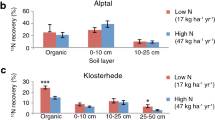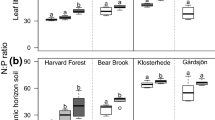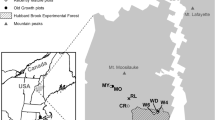Abstract
Despite long-term enhanced nitrogen (N) inputs, forests can retain considerable amounts of N. While rates of N inputs via throughfall and N leaching are increased in coniferous stands relative to deciduous stands at comparable sites, N leaching below coniferous stands is disproportionally enhanced relative to the N input. A better understanding of factors affecting N retention is needed to assess the impact of changing N deposition on N cycling and N loss of forests. Therefore, gross N transformation pathways were quantified in undisturbed well-drained sandy soils of adjacent equal-aged deciduous (pedunculate oak (Quercus robur L.)) and coniferous (Scots pine (Pinus sylvestris L.)) planted forest stands located in a region with high N deposition (north Belgium). In situ inorganic 15N labelling of the mineral topsoil (0–10 cm) combined with numerical data analysis demonstrated that (i) all gross N transformations differed significantly (p < 0.05) between the two forest soils, (ii) gross N mineralization in the pine soil was less than half the rate in the oak soil, (iii) meaningful N immobilization was only observed for ammonium, (iv) nitrate production via oxidation of organic N occurred three times faster in the pine soil while ammonium oxidation was similar in both soils, and (v) dissimilatory nitrate reduction to ammonium was detected in both soils but was higher in the oak soil. We conclude that the higher gross nitrification (including oxidation of organic N) in the pine soil compared to the oak soil, combined with negligible nitrate immobilization, is in line with the observed higher nitrate leaching under the pine forest.







Similar content being viewed by others
References
Aber J, McDowel W, Nadelhoffer K, Magill A, Berntson G, Kamakea M, McNulty S, Currie W, Rustad L, Fernandez I (1998) Nitrogen saturation in temperate forest ecosystems. Hypotheses revisited. Bioscience 48:921–934
Andresen LC, Jonasson S, Ström L, Michelsen A (2008) Uptake of pulse injected nitrogen by soil microbes and non-mycorrhizal plants in a species-diverse subarctic heath ecosystem. Plant Soil 313:283–295
Arnold J, Corre MD, Veldkamp E (2008) Cold storage and laboratory incubation of intact soil cores do not reflect in situ nitrogen cycling rates of tropical forest soils. Soil Biol Biochem 40:2480–2483. doi:10.1016/j.soilbio.2008.06.001
Augusto L, Ranger J, Binkley D, Rothe A (2002) Impact of several common tree species of European temperate forests on soil fertility. Ann For Sci 59:233–253
Barnard R, Leadley PW (2005) Global change, nitrification, and denitrification: a review. Global Biogeochem. Cycles 19:GB1007. doi:10.1029/2004GB002282
Bengtsson G, Bergwall C (2000) Fate of 15N labelled nitrate and ammonium in a fertilized forest soil. Soil Biol Biochem 32:545–557
Bengtsson G, Bengtson P, Månsson KF (2003) Gross nitrogen mineralization-, immobilization-, and nitrification rates as a function of soil C/N ratio and microbial activity. Soil Biol Biochem 35:143–154
Binkley D, Giardina C (1998) Why do tree species affect soils? The warp and woof of tree-soil interactions. Biogeochemistry 42:89–106
Booth MS, Stark JM, Rastetter E (2005) Controls on nitrogen cycling in terrestrial ecosystems: a synthetic analysis of literature data. Ecol Monogr 75:139–157
Booth MS, Stark JM, Hart SC (2006) Soil-mixing effects on inorganic nitrogen production and consumption in forest and shrubland soils. Plant Soil 289:5–15
Brant JB, Myrold DD, Sulzman EW (2006) Root controls on soil microbial community structure in forest soils. Oecologia 148:650–659. doi:10.1007/s00442-006-0402-7
Brierley EDR, Wood M, Shaw PJA (2001) Influence of tree species and ground vegetation on nitrification in an acid forest soil. Plant Soil 229:97–104
Burger M, Jackson LE (2004) Plant and microbial nitrogen use and turnover: rapid conversion of nitrate to ammonium in soil with roots. Plant Soil 266:289–301
Burnham KP, Anderson DR (2002) Model selection and inference: a practical information-theoretic approach, 2nd edn. Springer-Verlag, New York
Butterbach-Bahl K, Gasche R, Willibald G, Papen H (2002) Exchange of N-gases at the Höglwald forest—a summary. Plant Soil 240:117–123
Christenson LM, Lovett GM, Weathers KC, Arthur MA (2009) The influence of tree species, nitrogen fertilization, and soil C to N ratio on gross soil nitrogen transformations. Soil Sci Soc Am J 73:638–646
Compton JE, Boone RD (2002) Soil nitrogen transformations and the role of light fraction organic matter in forest soils. Soil Biol Biochem 31:933–943
Corre MD, Beese FO, Brumme R (2003) Soil nitrogen cycle in high nitrogen deposition forest: changes under nitrogen saturation and liming. Ecol Appl 13:287–298
Craenen H, Van Ranst E, Tack FMG, Verloo MG (2000) Calculation and mapping of critical loads of sulphur and nitrogen in Flanders, Belgium. Sci Tot Environ 254:55–64
De Boer W, Kowalchuk GA (2001) Nitrification in acid soils: micro-organism and mechanisms. Soil Biol Biochem 33:853–866
De Schrijver A, Geudens G, Augusto L, Staelens J, Mertens J, Wuyts K, Gielis L, Verheyen K (2007) The effect of forest type on throughfall deposition and seepage flux: a review. Oecologia 153:663–674. doi:10.1007/s00442-007-0776-1
De Schrijver A, Geudens G, Wuyts K, Staelens J, Gielis L, Verheyen K (2009) Nutrient cycling in two continuous cover scenarios for forest conversion of pine plantations on sandy soil. I. Nutrient cycling via aboveground tree biomass. Can J For Res 39:441–452. doi:10.1139/X08-176(IF:1.246)
de Vries FT, Bååth E, Kuyper TW, Bloem J (2009) High turnover of fungal hyphae in incubation experiments. FEMS Microbiol Ecol 67:389–396. doi:10.1111/j.1574-6941.2008.00643.x
Drury CF, Beauchamp EG (1991) Ammonium fixation, release, nitrification, and immobilization in high- and low-fixing Soils. Soil Sci Soc Am J 55:125–129
Ellis S, Dendooven L, Goulding KWT (1996) Quantitative assessment of soil nitrate disappearance and N2O evolution during denitrification. Soil Biol Biochem 28:589–595
Fitzhugh RD, Lovett GM, Venterea RT (2003) Biotic and abiotic immobilization of ammonium, nitrite and nitrate in soils developed under different tree species in the Catskill Mountains, New York, USA. Global Change Biol 9:1591–1601. doi:10.1046/j.1529-8817.2003.00694.x
Frank DA, Groffman PM (2009) Plant rhizospheric N processes: what we don’t know and why we should care. Ecology 90:1512–1519
Hackl E, Pfeffer M, Donat C, Bachmann G, Zechmeister-Boltenstern S (2005) Composition of the microbial communities in the mineral soil under different types of natural forest. Soil Biol Biochem 37:661–671. doi:10.1016/j.soilbio.2004.08.023
Hart SC, Stark JM, Davidson EA, Firestone MK (1994) Nitrogen mineralization, immobilization, and nitrification. In: Weaver RW, Angle S, Bottomley P, Bezdicek D, Smith S, Tabatabi A, Wollum A (eds) Methods of soil analysis. Part 2. Microbiological and biochemical properties. Soil Science Society of America, Madison, WI, pp 985–1018
Hauck RD (1982) Nitrogen isotope ratio analysis. In: Page AL, Miller RA, Keeney DR (eds) Methods of soil analysis. American Society of Agronomy, Madison, pp 735–779
Herman DJ, Johnson KK, Jaeger CH III, Schwartz E, Firestone MK (2006) Root influence on nitrogen mineralization and nitrification in Avena barbata rhizosphere soil. Soil Sci Soc Am J 70:1504–1511
Hodge A, Robinson D, Fitter A (2000) Are microorganisms more effective than plants at competing for nitrogen? Trend Plant Sci 5:304–308
Högberg MN, Chen Y, Högberg P (2007) Gross nitrogen mineralisation and fungi-to-bacteria ratios are negatively correlated in boreal forests. Biol Fertil Soils 44:363–366. doi:10.1007/s00374-007-0215-9
Howard PJA, Howard DM (1990) Titrable acids and bases in tree and shrub leaf litters. Forestry 63:178–196
Huygens D, Rütting T, Boeckx P, Van Cleemput O, Godoy R, Müller C (2007) Soil nitrogen conservation mechanisms in a pristine south Chilean Nothofagus forest ecosystem. Soil Biol Biochem 39:2448–2458. doi:10.1016/j.soilbio.2007.04.013
Huygens D, Boecxk P, Templer P, Paulino L, Van Cleemput O, Oyarzún C, Müller C, Godoy R (2008) Mechanisms for retention of bioavailable nitrogen in volcanic rainforest soils. Nat Geosci 1:543–548. doi:10.1038/ngeo252
Jabiol B, Brêthes A, Ponge J-F, Toutain F, Brun J-J (1995) L’humus sous toutes ses formes. Ecole nationele du génie rural, des eaux et des forêts, Nancy, p 64
Janssen PHM, Heuberger PCS (1995) Calibration of process-oriented models. Ecol Model 83:55–66
Johnson DW, Cheng W, Burke IC (2000) Biotic and abiotic nitrogen retention in a variety of forest soils. Soil Sci Soc Am J 64:1503–1514
Jordan FL, Cantera JJL, Fenn ME, Stein LY (2005) Autotrophic ammonia-oxidizing bacteria contribute minimally to nitrification in a nitrogen-impacted forested ecosystem. Appl Environ Microbiol 71:197–206. doi:10.1128/AEM.71.1.197-206.2005
Killham K (1990) Nitrification in coniferous forest soils. Plant Soil 128:31–44
Knorr M, Frey SD, Curtis PS (2005) Nitrogen additions and litter decomposition: a meta-analysis. Ecology 86:3252–3257
Laughlin RJ, Rütting T, Müller C, Watson CJ, Stevens RJ (2009) Effect of acetate on soil respiration, N2O emissions and gross N transformations related to fungi and bacteria in a grassland soil. Appl Soil Ecol 42:25–30. doi:10.1016/j.apsoil.2009.01.004
Lovett GM, Weathers KC, Arthur MA, Schultz JC (2004) Nitrogen cycling in a northern hardwood forest: do species matter? Biogeochemistry 76:289–308
Mary B, Recous S, Robin D (1998) A model for calculating nitrogen fluxes in soil using 15N tracing. Soil Biol Biochem 30:1936–1979
Müller C, Stevens RJ, Laughlin RJ (2004) A 15N tracing model to analyse N transformations in old grassland soil. Soil Biol Biochem 36:619–632. doi:10.1016/j.soilbio.2003.12.006
Müller C, Rütting T, Kattge J, Laughlin RJ, Stevens RJ (2007) Estimation of parameters in complex 15N tracing models via Monte Carlo sampling. Soil Biol Biochem 39:715–726. doi:10.1016/j.soilbio.2006.09.021
Müller C, Rütting T, Abbasi MK, Laughlin RJ, Kammann C, Clough TJ, Sherlock RR, Kattge J, Jäger H-J, Watson CJ, Stevens RJ (2009) Effect of elevated CO2 on soil N dynamics in a temperate grassland soil. Soil Biol Biochem 41:1996–2001. doi:10.1016/j.soilbio.2009.07.003
Mulvaney RL (1996) Nitrogen-inorganic forms. In: Sparks DL (ed) Methods of soil analysis. American Society of Agronomy, Madison, pp 1123–1184
Myrold DD, Tiedje JM (1986) Simultaneous estimation of several nitrogen cycle rates using 15N: theory and application. Soil Biol Biochem 18:559–568
Payton ME, Miller AE, Raun WR (2000) Testing statistical hypotheses using standard error bars and confidence intervals. Comm Soil Sci Plant Analysis 31:547–551
Pedersen H, Dunkin KA, Firestone MK (1999) The relative importance of autotrophic and heterotrophic nitrification in a conifer forest soil as measured by 15N tracer and pool dilution techniques. Biogeochemistry 44:135–150
Pett-Ridge J, Silver WL, Firestone MK (2006) Redox fluctuations frame microbial community impacts on N-cycling rates in a humid tropical forest soil. Biogeochemistry 81:95–110. doi:10.1007/s/10533-006-9032-8
Priha O, Smolander A (1999) Nitrogen transformations in soil under Pinus sylvestris, Picea abies and Betula pendula at two forest sites. Soil Biol Biochem 31:965–977
Priha O, Grayston SJ, Hiukka R, Pennanen T, Smolander A (2001) Microbial community structure and characteristics of the organic matter in soils under Pinus sylvestris, Picea abies, and Betula pendula at two forest sites. Biol Fertil Soils 33:17–24
Reich PB, Oleksyn J, Modrzynski J, Mrozinski P, Hobbie SE, Eissenstat DM, Chorover J, Chadwick OA, Hale CM, Tjoelker GM (2005) Linking litter calcium, earthworms and soil properties: a common garden test with 14 tree species. Ecol Lett 8:811–818. doi:10.1111/j.1461-0248.2005.00779.x
Roing K, Andren O, Mattsson L (2006) Non-exchangeable’ ammonium in soils from Swedish long-term agricultural experiments: Mobilization and effects of fertilizer application. Acta Agricult Scand B 56:197–205. doi:10.1080/09064710510038069
Russow R, Spott O, Stange CF (2008) Evaluation of nitrate and ammonium as sources of NO and N2O emissions from black earth soils (Haplic Chernozem) based on N-15 field experiments. Soil Biol Biochem 40:380–391. doi:10.1016/j.soilbio.2007.08.020
Rütting T, Müller C (2007) 15N tracing models with a Monte Carlo optimization procedure provide new insights on gross N transformations in soil. Soil Biol Biochem 39:2351–2361. doi:10.1016/j.soilbio.2007.04.006
Rütting T, Müller C (2008) Process-specific analysis of nitrite dynamics in a permanent grassland soil by using a Monte Carlo sampling technique. Eur J Soil Sci 59:208–215. doi:10.1111/j.1365-2389.2007.00976.x
Rütting T, Huygens D, Müller C, Van Cleemput O, Godoy R, Boeckx P (2008) Functional role of DNRA and nitrite reduction in a pristine south Chilean Nothofagus forest. Biogeochemistry 90:243–258
Rütting T, Clough TJ, Müller C, Lieffering M, Newton PCD (2010) Ten years of elevated atmospheric carbon dioxide alters soil nitrogen transformations in a sheep-grazed pasture. Glob Change Biol 16:2530–2542. doi:10.1111/j.1365-2486.2009.02089.x
Rütting T, Huygens D, Staelens J, Müller C, Boeckx P (2011) Advances in 15N tracing experiments: new labelling and data analysis approaches. Biochem Soc Trans 39:279–283
Saghir NS, Mulvaney RL, Azam F (1993) Determination of nitrogen by microdiffusion in mason jars. 1. Inorganic nitrogen in soil extracts. Comm Soil Sci Plant Anal 24:1745–1762
Schimel JP (1996) Assumptions and errors in the 15NH4 + pool dilution technique for measuring mineralization and immobilization. Soil Biol Biochem 28:827–828
Schimel JP, Benett J (2004) Nitrogen mineralization: challenges of a changing paradigm. Ecology 84:591–602
Schmidt SK, Costello EK, Nemergut DR, Cleveland CC, Reed SC, Weintraub MN, Meyer AF, Martin AM (2007) Biogeochemical consequences of rapid microbial turnover and seasonal succession in soil. Ecology 88:1379–1385
Schöpp W, Posch M, Mylona S, Johansson M (2003) Long-term development of acid deposition (1880–2030) in sensitive freshwater regions in Europe. Hydrol Earth Syst Sci 7:436–446
Silver WL, Thompson AW, Reich A, Ewel JJ, Firestone MK (2005) Nitrogen cycling in tropical plantation forests: potential controls on nitrogen retention. Ecol Appl 15:1604–1614
Sotta ED, Corre MD, Veldkamp E (2008) Differing N status and N retention processes of soils under old-growth lowland forest in Eastern Amazonia, Caxiuanã, Brazil. Soil Biol Biochem 40:740–750. doi:10.1016/j.soilbio.2007.10.009
Spiecker H, Hansen J, Hasenauer H, Klimo E, Skovsgaard JP, Sterba H, von Teuffel K (eds) (2004) Norway spruce conversion—options and consequences. Research report 18. European Forest Institute, Boston
Stark JM, Hart SC (1997) High rates of nitrification and nitrate turnover in undisturbed coniferous forests. Nature 358:61–64
Stevens RJ, Laughlin RJ (1994) Determining nitrogen-15 in nitrite or nitrate by producing nitrous oxide. Soil Sci Soc Am J 58:1108–1116
Templer PH, Silver WL, Pett-Ridge J, DeAngelis KM, Firestone MK (2008) Plant and microbial controls on nitrogen retention and loss in a humid tropical forest. Ecology 89:3030–3040
Tiedje JM, Sexstone AJ, Myrold DD, Robinson JA (1982) Denitrification—ecological niches, competition and survival. Anton Leeuw J Microbiol 48:569–583
Tietema A, Van Dam D (1996) Calculating microbial carbon and nitrogen transformations in acid forest litter with 15N enrichment and dynamic simulation modelling. Soil Biol Biochem 28:953–965
Trap J, Bureau F, Vinceslas-Akpa M, Chevalier R, Aubert M (2009) Changes in soil N mineralization and nitrification pathways along a mixed forest chronosequence. For Ecol Manag 258:1284–1292
Van Herzele A, Van Gossum P (2009) Owner-specific factors associated with conversion activity in secondary pine plantations. For Pol Econ 11:230–236
Venterea RT, Groffman PM, Verchot LV, Magill AH, Aber JD (2004) Gross nitrogen process rates in temperate forest soils exhibiting symptoms of nitrogen saturation. For Ecol Manag 196:129–142
Verchot LV, Holmes Z, Mulon L, Groffman PM, Lovett GM (2001) Gross vs net rates of N mineralization and nitrification as indicators of function differences between forest types. Soil Biol Biochem 33:1889–1901
Vervaet H, Boeckx P, Boko AMC, Van Cleemput O, Hofman G (2004) The role of gross and net N transformation processes and NH4 + and NO3 − immobilization in controlling the mineral N pool of a temperate mixed deciduous forest soil. Plant Soil 264:349–357
von Wilpert K, Zirlewagen D, Kohler M (2000) To what extent can sylviculture enhance sustainability of forest sites under the immission regimes in Central Europe? Water Air Soil Poll 122:105–120
Yan E-R, Wang X-H, Huang J-J, Li G-Y, Zhou W (2008) Decline of soil nitrogen mineralization and nitrification during forest conversion of evergreen broad-leaved forest to plantations in the subtropical area of Eastern China. Biogeochemistry 89:239–251. doi:10.1007/s10533-008-9216-5
Zeller B, Recous S, Kunze M, Moukoumi J, Colin-Belgrand M, Bienaimé S, Ranger J, Dambrine E (2007) Influence of tree species on gross and net N transformations in forest soils. Ann For Sci 64:151–158
Zhong Z, Makeshin F (2004) Comparison of soil nitrogen dynamics under beech, Norway spruce and Scots pine in central Germany. Eur J For Res 123:29–37. doi:10.1007/s10342-004-0021-y
Acknowledgments
We thank Evy Ampoorter, Lander Baeten, Dries Roobroeck, Margot Vanhellemont, and Luc Willems for their help with the nitrogen additions and soil processing, and Eric Gillis, Katja Van Nieuland, and Jan Vermeulen for assisting in the laboratory work. Mme Goossens and Natuurpunt vzw are acknowledged for the kind permission to use their forest stands for this research project. We would like to thank the associate editor and two anonymous reviewers for their valuable comments on the manuscript. The first, third and fourth author were funded as postdoctoral fellow of the Research Foundation-Flanders (FWO) and the second author is supported by NitroEurope IP under the EC 6th Framework Programme (Contract No. 017841).
Author information
Authors and Affiliations
Corresponding author
Rights and permissions
About this article
Cite this article
Staelens, J., Rütting, T., Huygens, D. et al. In situ gross nitrogen transformations differ between temperate deciduous and coniferous forest soils. Biogeochemistry 108, 259–277 (2012). https://doi.org/10.1007/s10533-011-9598-7
Received:
Accepted:
Published:
Issue Date:
DOI: https://doi.org/10.1007/s10533-011-9598-7




